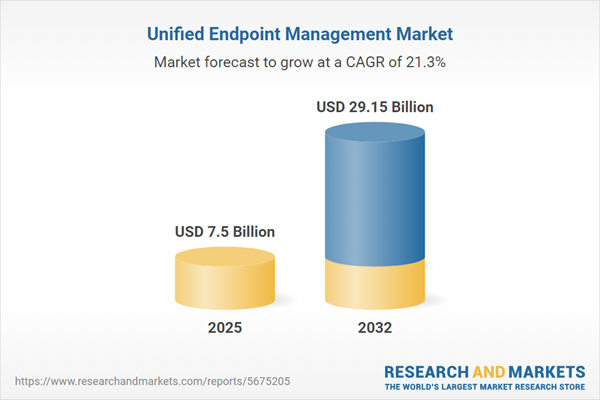Speak directly to the analyst to clarify any post sales queries you may have.
Unified endpoint management is an essential enabler for safeguarding organizational assets and ensuring operational oversight across modern digital workplaces. As device diversity grows and security standards evolve, integrated endpoint solutions are critical for supporting business resilience and maintaining compliance in distributed environments.
Market Snapshot: Unified Endpoint Management Market Size and Dynamics
The unified endpoint management market is experiencing robust momentum, with the sector’s value forecasted to increase from USD 6.20 billion in 2024 to USD 7.50 billion by 2025, and projected to reach USD 29.15 billion by 2032. This growth, reflecting a compound annual growth rate (CAGR) of 21.33%, is fueled by greater enterprise implementation of adaptive security strategies, expanding device fleets, and a strategic shift towards secure, distributed work models. The hybrid work movement and intensifying regulatory mandates prompt leaders to heighten their compliance controls and reinforce secure remote infrastructure to navigate uncertainty in today’s operating landscape.
Scope & Segmentation: Unified Endpoint Management Market
This report delivers actionable insights for executives, CISOs, and managed service providers evaluating unified endpoint management technologies and investment decisions. The following strategic segmentation areas are key to aligning technology adoption with operational demands and compliance imperatives at scale:
- Component: Managed services and professional services are foundational, complemented by core technologies spanning endpoint security, identity and access management, mobile device management, and mobile application management. These elements support scalable and unified security for enterprise environments.
- Deployment Mode: Cloud-based solutions offer flexibility and integration benefits for enterprises seeking scalability, while on-premises options provide granular control for organizations operating in regulated or complex settings.
- Organization Size: Large enterprises prioritize standardized policy frameworks for governance. Small and medium businesses seek streamlined compliance and enhanced operational efficiencies given resource limitations.
- Industry Vertical: Sectors such as banking and financial services, education, healthcare, government and defense, IT and telecom, manufacturing, retail, and logistics introduce distinctive regulatory and security drivers that shape endpoint management priorities.
- Device Type: Laptops, desktops, smartphones, and tablets are managed within unified policies to ensure comprehensive, responsive control across heterogeneous digital landscapes.
- Operating System: Integrated oversight extends across Android, iOS, Linux, MacOS, and Windows, supporting both device variety and secure operations without sacrificing transparency or management.
- Region: The Americas, Europe, Middle East and Africa, and Asia-Pacific each feature unique regulatory frameworks and adoption patterns, necessitating regionalized endpoint management approaches for optimal effectiveness.
- Leading Vendors and Ecosystem Participants: Microsoft Corporation, VMware, IBM, Citrix, Ivanti, Zoho Corporation, SOTI, Jamf, Cisco, and BlackBerry Limited continuously define best practices and shape the global endpoint management ecosystem.
Key Takeaways for Unified Endpoint Management Decision-Makers
- Centralizing endpoint oversight simplifies device administration and elevates protection, supporting secure workforce operations as organizational complexity grows.
- Integrating artificial intelligence and machine learning enhances early detection of security threats, reducing manual effort for IT teams facing rapid device expansion.
- Zero trust frameworks enforce robust access control at every connection point, protecting enterprise systems from diverse risks.
- Adaptive policy structures help regulated industries meet compliance demands efficiently, allowing for quick pivots in response to market or regulatory changes.
- Seamless integration with cloud and identity platforms extends solution scalability and enables organizations to adjust endpoint strategies amid business shifts.
Tariff Impact: Addressing Supply Chain and Cost Challenges
Tariffs affecting hardware components, particularly in the United States, are prompting enterprises to re-examine device procurement strategies and lifecycle management. Organizations are increasingly adopting diversified supplier networks and device-as-a-service models to maintain cost control and quickly respond to regulatory fluctuations. This strategic flexibility is necessary for sustaining consistent endpoint coverage during ongoing supply chain disruptions and adhering to evolving compliance standards.
Methodology & Data Sources
The analysis integrates direct insights from C-level interviews, comprehensive vendor documentation reviews, and monitoring of regulatory developments. Sectoral case studies underpin specific recommendations, ensuring guidance reflects the operational and security needs unique to varied industries.
Why This Report Matters
- Provides a structured framework for connecting unified endpoint management initiatives with enterprise security, compliance, and IT modernization efforts.
- Enables leadership teams to benchmark vendor solutions and deployment models for alignment with industry-specific and regional requirements.
- Delivers evidence-based recommendations to optimize workflows, build resilient endpoint strategies, and guide future technology investments.
Conclusion
Unified endpoint management is central to sustaining enterprise security and enabling operational agility. This report empowers stakeholders to manage endpoint oversight with confidence while adapting to shifting technology and regulatory demands.
Additional Product Information:
- Purchase of this report includes 1 year online access with quarterly updates.
- This report can be updated on request. Please contact our Customer Experience team using the Ask a Question widget on our website.
Table of Contents
3. Executive Summary
4. Market Overview
7. Cumulative Impact of Artificial Intelligence 2025
Companies Mentioned
The companies profiled in this Unified Endpoint Management market report include:- Microsoft Corporation
- VMware, Inc.
- International Business Machines Corporation
- Citrix Systems, Inc.
- Ivanti, Inc.
- Zoho Corporation
- SOTI Inc.
- Jamf, LLC
- Cisco Systems, Inc.
- BlackBerry Limited
Table Information
| Report Attribute | Details |
|---|---|
| No. of Pages | 180 |
| Published | October 2025 |
| Forecast Period | 2025 - 2032 |
| Estimated Market Value ( USD | $ 7.5 Billion |
| Forecasted Market Value ( USD | $ 29.15 Billion |
| Compound Annual Growth Rate | 21.3% |
| Regions Covered | Global |
| No. of Companies Mentioned | 11 |









